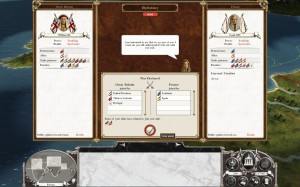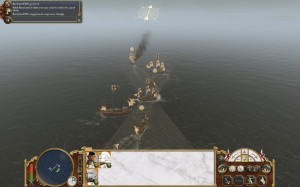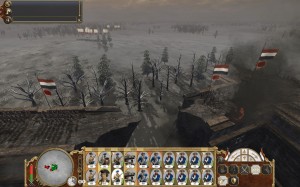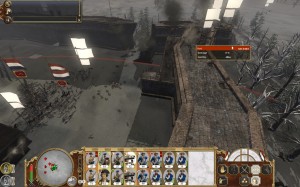The following post, by Peter Davies (aka Beefeater1980), playing France, is the belated first instalment in the Empire: Total War multiplayer campaign write up! Click here to see what it’s all about.
In this episode, Britain and France go to war on the high seas and in the Low Countries. Will one side score a knockout blow early on? Or will the war turn into an early stalemate?
Over to PD…
***
Here they come (Crick! Crack! Bang!), those red-coated, black-booted, musket-toting minions of a mercantile empire, flags waving and cannons bristling. In ETW, Britain has advantages to make a royal weep and hang up his ius primae nocti: unassailable home regions in Europe that can each churn out a land unit or several every turn; high-value ports, ready to knock out those sleek and deadly fifth-rate ships that will demolish the sixth-raters I can build in the time it takes to say ‘Hornblower’; and the most powerful alliance in Europe at its beck and call.
Against them stands France and my enviable record of five defeats and no wins against the campaign AI on ‘Normal’. Oh, and Spain as an ally: 10/10 for machismo but, in deference to Real Historical Fact, her glory days are behind her and she will lose interest a few years in, only to spend the rest of the game swigging Sangria and reminiscing about Pizarro and Cortes. Gentlemen, place your bets!
And yet. PS may have more and better ships and an invulnerable home base but the British army starts the game small and unimposing: France on the other hand has a solid core of infantry, cavalry and artillery in Europe itself and a huge income from her home regions – after a couple of turns I was pulling in around 8000 income per turn net despite a comprehensive trade blockade. If anyone can save the world from the fate of British hegemony, association football and the expression ‘eff off’, it is La Grande Nation.
LE PLAN: France is likely to fall behind Britain diplomatically early on, since my fleet is made up of a couple of bathtubs floating in the channel with only three one-eyed gunners between them. Unfortunately, the one thing CA didn’t mess up in programming this game was making the AI a vicious little jerk whose sole aim is to kick hard in the unmentionables the human player it judges to be weakest. Naval strength is a major component of that determination. Left to their own devices, Britain’s AI allies (Portugal, Netherlands and Austria) will declare war on me in the first few turns, leading to a three-front war on sea and land and a very, very short LP.
However, I have a cunning plan. Because my position starts uncertain, Peter S (who is a solid strategist) will probably expect me to try for a boom, building a couple of grant continental armies – he’ll never suspect a pre-emptive attack. This isn’t as crazy as it sounds: attacking in turn 1 will force Britain’s scary allies to make a snap decision on whether to join the war at a time when the calculus is more likely to be more favourable to me. This is why my first action in the game is to move my leaky little fleet to attack the nearest British armada, a move which goes swimmingly in the sense that the remains of my navy are now doing the breast-stroke back to Le Havre.
A SHAMEFUL DISPLAY! Over the next couple of turns, PS moves his fleets into both of my northern ports, leaving them smoking ruins. However, what we lose on the swings, we gain on the roundabouts. Austria and Hanover – the only land powers in Britain’s coalition – decided that they had better things to do than get in a bust-up with my army and have said ‘Nein’ to this war.
On the home front, while conventional wisdom is to tear down those religious schools as soon as possible and replace them with hotbeds of radical study so as to speed off down the tech tree. I want to see if the additional tax and stability I get from keeping Europe Catholic can outweigh this, so I’m following the Jesuit path for now. It will be interesting to see how this pans out.
DIPLOMACY: Diplomacy? Diplomacy! I’m worried about protecting my American colonies, since I need all my resources for the struggle in Europe. To get around this, I sell a few of my less wealthy colonies to Spain for 1000 / turn over 10 turns. It’s probably not a great deal, but it’s better than trying to extract income from provinces I can’t reliably hold.
Over the next couple of turns, I start my army marching on Amsterdam. My initial plan was to carry out the siege for the full 5 turns, but immediately after deciding to end turn 4, I get a bad case of invader’s regret; now that he’s smashed my fleet, PS probably has an army inbound and, while it’s not going to be as big as France’s, if it catches our force at the walls of Amsterdam, my only army is going to be ground into so much mincemeat. Since I have more artillery than the defenders, I will try an assault next turn, and hope that it it goes badly I’ll have enough of a force intact to hold off a British counterattack until reinforcements get there.
Drawn up before the walls of Amsterdam. Imposing, aren’t they.

Onward for France! They charge, they charge…
…and they retreat, as natural to my troops as eating frogs and cruelty to geese.
Things are looking bleak for L’Hexagone.



